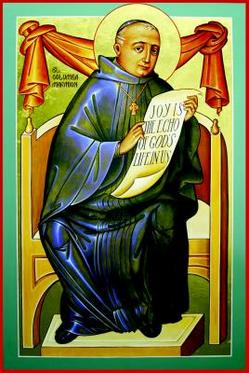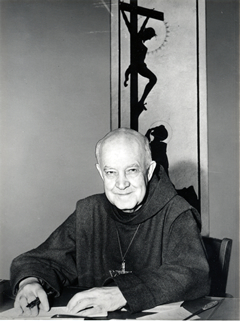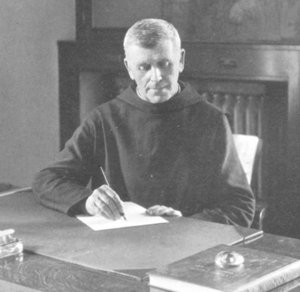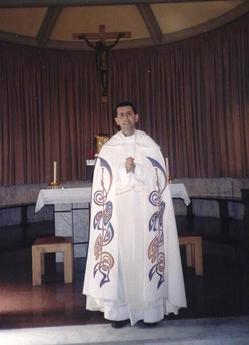 Today, it seems, is a day of remembering because it is an anniversary of two important witnesses of Jesus Christ: one is Blessed Pope John XXIII and the other is the 35 year old Iraqi priest, Father Ragheed Ganni. A Chaldean Catholic priest, Ganni was killed with three of his deacons after celebrating the Holy Mysteries. Forced from their car they were told to renounce faith in Christ and make their submission to Islam. They refused to renounce Christ and were gunned down.
Today, it seems, is a day of remembering because it is an anniversary of two important witnesses of Jesus Christ: one is Blessed Pope John XXIII and the other is the 35 year old Iraqi priest, Father Ragheed Ganni. A Chaldean Catholic priest, Ganni was killed with three of his deacons after celebrating the Holy Mysteries. Forced from their car they were told to renounce faith in Christ and make their submission to Islam. They refused to renounce Christ and were gunned down.
Category: Sainthood causes
Matteo Ricci: 4th centenary of death
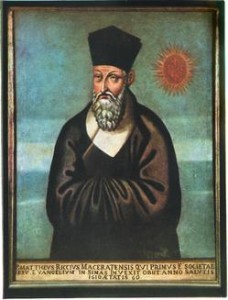 We’re observing the anniversary of death of the famed Jesuit, Matteo Ricci. Benedict XVI wrote to Bishop Claudio Giuliodori of Macerata-Tolentino-Recanati-Cingoli-Treia, Italy on the occasion of a Jubilee Year commemorating the fourth centenary of the death of the Jesuit Father Matteo Ricci, who died in Beijing, China on 11 May 1610. In part the Pope said:
We’re observing the anniversary of death of the famed Jesuit, Matteo Ricci. Benedict XVI wrote to Bishop Claudio Giuliodori of Macerata-Tolentino-Recanati-Cingoli-Treia, Italy on the occasion of a Jubilee Year commemorating the fourth centenary of the death of the Jesuit Father Matteo Ricci, who died in Beijing, China on 11 May 1610. In part the Pope said:
In considering his intense academic and spiritual activity, we cannot but remain favourably impressed by the innovative and unusual skill with which he, with full respect, approached Chinese cultural and spiritual traditions. It was, in fact, this approach that characterised his mission, which aimed to seek possible harmony between the noble and millennial Chinese civilisation and the novelty of Christianity, which is for all societies a ferment of liberation and of true renewal from within, because the Gospel, universal message of salvation, is destined for all men and women whatever the cultural and religious context to which they belong.
A biography of Father Ricci can be read here.
More about Father Ricci can be found here and here.
For those with a deeper curiosity I could recommend Jonathan D. Spence’s The Memory Palace of Matteo Ricci.
Columba Marmion: the canonization process
Following the progression of saint-making is interesting, though it can be tedious. If you are interested, there is an article in the March 2009 issue of The American Benedictine Review (60:1) by Dom Oliver Raquez, OSB: “Memoirs of the Postulator for the Cause of Blessed Columba Marmion.” The author takes you through Marmion’s canonization process from beginning to the present including the miracles and future work that would make Blessed Columba more known.
John Paul II, remembered
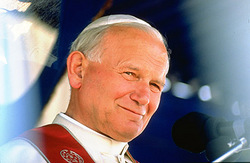 Today marks the fourth anniversary of the death of our beloved Pope John Paul II. His physical absence is felt but I believe that he’s interceding before the throne of grace for those who ask.
Today marks the fourth anniversary of the death of our beloved Pope John Paul II. His physical absence is felt but I believe that he’s interceding before the throne of grace for those who ask.
I consider myself in the John Paul generation and I look forward to the day that the Church beatifies and canonizes him. Even though I love Pope Benedict, I still love Pope John Paul. May his memory be eternal.
God, Who, in Thine ineffable providence, didst will that Thy servant John Paul II should be numbered among the high priests, grant, we beseech Thee, that he, who on earth held the place of Thine only-begotten Son, may be joined forevermore to the fellowship of Thy holy pontiffs. Through Christ our Lord.
Some newsworthy items:
Sophia Loren speaks about John Paul moving toward sainthood.
A Rabbi speaks about John Paul.
A video clip on the 6pm Mass offered by Pope Benedict for Pope John Paul II.
A video clip on the documentation of Pope John Paul’s move toward being called saint.
Carl Anderson reflects on his relationship with the Servant of God Pope John Paul II on this 4th anniversary of the Pope’s death.
Tomas Munk, Jesuit novice killed by the Nazis
 Last year the Society of Jesus in Slovakia has put a considerable effort in drawing the attention to a novice, Tomas Munk, who converted to Catholicism from Judaism in the late 1930s.
Last year the Society of Jesus in Slovakia has put a considerable effort in drawing the attention to a novice, Tomas Munk, who converted to Catholicism from Judaism in the late 1930s.
In the spring of 2008 a book of Ivan Petransky about his life was published Zivot pod hviezdou (“A life under a star”). People from around the Jesuit community in Ruzomberok have organized a concert to remember this young brave man who in his early life had written: Amor Christi usque ad oblivionem sui – Love for Christ until self-oblivion. The local TV station has produced a documentary DVD on his life and people are very much interested in the witness this young man has got to offer. Parts of the published book were broadcasted on the Catholic radio station in the country.
Tomas Munk was born in Budapest on January 29, 1924 as the first son of a Jewish couple. After conversion in 1939 he was received in the Catholic Church. Tomas studied in Bratislava and partly in Ruzomberok. He decided to become priest in the Society of Jesus where he entered on July 30, 1943. In the autumn of 1944, Nazi soldiers came in Ruzomberok. After several months the whole family was arrested and the Nazi eventually came to the Novitiate and took him away as a Jewish convert. According to a fellow novice, now a respected Jesuit, Tomas confided to him having prayed all night in the Novitiate chapel: “I have sacrificed my life for my nation, for its conversion and for the Church.” Tomas was killed on the way to the concentration camp.
A point of connection for me with Tomas Munk is that we share the same birth date but 45 years apart from each other, and that we had a love of the Society. May he interceded for all of us.
Paul Wattson, convert, priest, founder, ecumenist, Servant of God
We draw near to God and He enters into our being. He dwells in us. He takes us into union with Himself. As the tree strikes roots down into the soil and that which yesterday was but a bit of dirt, today is part of the tree, so Christ reaches down through the mystery of the Incarnation and takes into union with Himself those that are willing to be lost and merged in Him. He lives in them and they can cry out with Saint Paul, “It is no longer I that live, but Christ who lives in me.” [Gal.2:20] It is that indwelling presence of Christ that satisfies the soul, which, if it seeks satiety elsewhere will never find it, and He leads the soul step by step, and if the person has his or her trials and sufferings —and we all do— in the midst of this wicked and naughty world we are to make atonement in union with Christ crucified on the Cross, for in His mystical body He is constantly reproducing His own crucifixion. (Fr. Paul’s sermon, December 25, 1925)
Francis J. Parater, Servant of God
 October 10, 1897 – February 7, 1920
October 10, 1897 – February 7, 1920
Loving Father, your servant Francis Joseph Parater sought perfection as a student, scout and seminarian. He offered himself to you completely through the Sacred Heart of Jesus. Through his intercession, may young people answer your call to follow Jesus as priests, deacons and religious. Grant, as well, the favors I seek, so that your Church will recognize his holiness and proclaim him Blessed.Grant this through Christ our Lord. Amen.
Lukas Etlin: Benedictine monk, priest, artist, adorer of Christ…
Dom Lukas Etlin
Monk of Conception Abbey
25 February 1864 – 16 December 1927
a cause for sainthood?
read more at Vultus Christi
118 years after the death of John Henry Newman, Venerable Servant of God
Today’s Catholic News Service reports that Cardinal Newman’s body will be moved
LONDON (CNS) — The British government has agreed to allow the exhumation of the
 body of a 19th-century cardinal whose cause for sainthood widely is expected to progress soon to beatification. The Ministry of Justice granted a license to allow undertakers to dig up the body of Cardinal John Henry Newman from a grave in a small cemetery in the suburbs of Birmingham, England, and transfer it to a marble sarcophagus in a church in the city, where it can be venerated by pilgrims. The license was expected to arrive Aug. 11, the 118th anniversary of the cardinal’s death in 1890. Approval had been delayed by several months because of a 19th-century law that forbids the transfer of bodies from graves to church tombs. But Sir Suma Chakrabarti, permanent secretary to the Ministry of Justice, finally decided to make a special exception to allow the exhumation to go ahead. Born in London in 1801, Cardinal Newman was an Anglican priest who led the Oxford movement in the 1830s to draw Anglicans to their Catholic roots. He converted to Catholicism at the age of 44 after a succession of clashes with Anglican bishops made him a virtual outcast from the Church of England.
body of a 19th-century cardinal whose cause for sainthood widely is expected to progress soon to beatification. The Ministry of Justice granted a license to allow undertakers to dig up the body of Cardinal John Henry Newman from a grave in a small cemetery in the suburbs of Birmingham, England, and transfer it to a marble sarcophagus in a church in the city, where it can be venerated by pilgrims. The license was expected to arrive Aug. 11, the 118th anniversary of the cardinal’s death in 1890. Approval had been delayed by several months because of a 19th-century law that forbids the transfer of bodies from graves to church tombs. But Sir Suma Chakrabarti, permanent secretary to the Ministry of Justice, finally decided to make a special exception to allow the exhumation to go ahead. Born in London in 1801, Cardinal Newman was an Anglican priest who led the Oxford movement in the 1830s to draw Anglicans to their Catholic roots. He converted to Catholicism at the age of 44 after a succession of clashes with Anglican bishops made him a virtual outcast from the Church of England.
The Venerable Servant of God John Henry Newman
The Venerable Servant of God John Henry Newman was born in London, 21 February
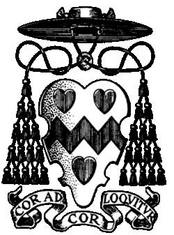 1801, and died Birmingham, 11 August 1890. As Vicar of Saint Mary’s Oxford he exerted a profound spiritual influence on the Church of England. Accepting true faith as professed and taught by the Catholic Church in 1845, he founded Oratories of Saint Philip Neri in Birmingham (1848) and later in London (1849) and was the first rector of the Catholic University in Dublin. Newman was made a Cardinal by Pope Leo XIII in 1879. Through his published writings and private correspondence he created a greater understanding of the Catholic Church and her teachings, helping many persons with their religious difficulties. At his death he was praised for his unworldliness, humility, and prayerful contact with God. Pope John Paul II declared Newman a “Venerable Servant of God” on 22 January 1991. At the 2nd century of the Cardinal’s birth Pope John Paul wrote:
1801, and died Birmingham, 11 August 1890. As Vicar of Saint Mary’s Oxford he exerted a profound spiritual influence on the Church of England. Accepting true faith as professed and taught by the Catholic Church in 1845, he founded Oratories of Saint Philip Neri in Birmingham (1848) and later in London (1849) and was the first rector of the Catholic University in Dublin. Newman was made a Cardinal by Pope Leo XIII in 1879. Through his published writings and private correspondence he created a greater understanding of the Catholic Church and her teachings, helping many persons with their religious difficulties. At his death he was praised for his unworldliness, humility, and prayerful contact with God. Pope John Paul II declared Newman a “Venerable Servant of God” on 22 January 1991. At the 2nd century of the Cardinal’s birth Pope John Paul wrote:
For his [Newman] tomb he chose the inscription: Ex umbris et imaginibus in veritatem; and it was clear at the end of his life’s journey that Christ was the truth he had found. But Newman’s search was shot through with pain. Once he had come to that unshakeable sense of the mission entrusted to him by God, he declared: “Therefore, I will trust Him… If I am in sickness, my sickness may serve Him, in perplexity, my perplexity may serve Him… He does nothing in vain… He may take away my friends. He may throw me among strangers. He may make me feel desolate, make my spirits sink, hide the future from me. Still, He knows what He is about” (Meditations and Devotions). All these trials he knew in his life; but rather than diminish or destroy him they paradoxically strengthened his faith in the God who had called him, and confirmed him in the conviction that God “does nothing in vain”. In the end, therefore, what shines forth in Newman is the mystery of the Lord’s Cross: this was the heart of his mission, the absolute truth which he contemplated, the “kindly light” which led him on.
Prayer for Canonization John Henry Newman
Eternal Father, You led John Henry Newman to follow the kindly light of Truth, and he obediently responded to your heavenly calls at any cost. As writer, preacher, counsellor and educator, as pastor, Oratorian, and servant of the poor he labored to build up your Kingdom.
Grant that through your Vicar on Earth we may hear the words, ‘Well done, thou good and faithful servant, enter into the company of the canonized saints.’
May you manifest your Servant’s power of intercession by even extraordinary answers to the prayers of the faithful throughout the world. We pray particularly for our intentions in his name and in the name of Jesus Christ your Son our Lord. Amen.
